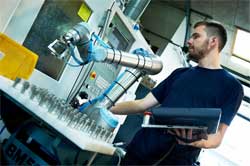
Posted to News on 5th Nov 2012, 22:13
Universal Robot can be used for collaborative working
This article explains how the six-axis industrial Universal Robot can be used as a collaborative robot alongside human operatives, with no need for physical guards, light curtains or other additional safety devices.

R.A. Rodriguez says that both the original UR5 Universal Robot and the recently introduced larger UR10 Universal Robot can be used without additional safeguards, subject to a satisfactory risk assessment being completed. Both six-axis anthropomorphic Universal Robots are designed to be readily portable and easily programmed so that they can be moved quickly from one task to the next, without the need for a specialist programmer (they are also remarkably cost-effective). The UR5 has a maximum payload of 5kg and a working radius of 0.85m, while the UR10 has a maximum payload of 10kg and a working radius of 1.3m. Both are designed to exert a maximum force of 150N and to comply with the necessary standards that permit their use as a 'collaborative robot' - which is one that can be used without safety guarding between the robot and the operator. This feature opens up many possibilities for collaborative working or simply makes it quicker and easier to install the robot without having to also install physical guards, light curtains or other safety devices.
Regulatory compliance
Universal Robots has prepared a Safety Guide to help 'integrators' (which may be a manufacturing company's production engineer, for example) create a safe installation and comply with the requirements of the Machinery Directive 2006/42/EC. The Guide explains that the robot is classified as a 'partly completed machine' and integrators are responsible for CE marking the installation - for which guidance is provided, including a list of typical hazards associated with the robot system. Part of the guide lists the features that enable the robot to be used as a collaborative robot. These are as follows:
- Control system is Category 3, Performance Level d
- High-level software generates a protective stop if the robot strikes something. This stop force limit is lower than 150N.
- Low-level software limits the torque generated by the joints, permitting only a small deviation from the expected torque.
- The software prevents program execution when the robot is not mounted as specified in the setup.
- The robot control system is redundant so that one system error will stop the robot or remove power from it.
- The weight of the robot is relatively low.
- The robot shape is smooth to reduce pressure per force.
- In the event of an emergency situation it is possible to move the joints of an unpowered robot (against the brakes) by applying human effort.
Already there are numerous examples of Universal Robots being used without guarding, as can be seen on YouTube:
Of course, if a risk assessment shows that some degree of guarding is required, it may be appropriate to use physical guarding, safety light curtains, pressure-sensitive mats, other safety measures or a combination as necessary. R.A. Rodriguez can help customers to source and integrate appropriate safety measures.
For customers who are sceptical about using a robot without guarding, R.A. Rodriguez can supply a copy of the Universal Robots Safety Guide and also a test report prepared by the Notified Body, the Danish Technological Institute, Centre for Materials Testing. This report confirms that the UR5 Universal Robot complies with the collaborative operation requirements in the applicable standards:
EN ISO 10218-1:2006 and ANSI/RIA/ISO 10218-1-2007*
- The robot shall be designed to ensure either a maximum dynamic power of 80W or a maximum static force of 150N at the flange or tool centre point (TCP).
EN ISO 10218-1:2011 and EN ISO 10218-2:2011*
- Parameters of power, force and ergonomics shall be determined by risk assessment. If any parameter limit is exceeded, a protective stop shall be issued.
* In the UK, BSI has published British Standard equivalents: BS EN ISO 10218-1:2011 'Robots and robotic devices. Safety requirements for industrial robots. Robots' and BS EN ISO 10218-2:2011 'Robots and robotic devices. Safety requirements for industrial robots. Robot systems and integration.
Follow the link for more information about Universal Robots, or contact R.A. Rodriguez to discuss specific applications, whether for conventional industrial robots or collaborative robots.






























